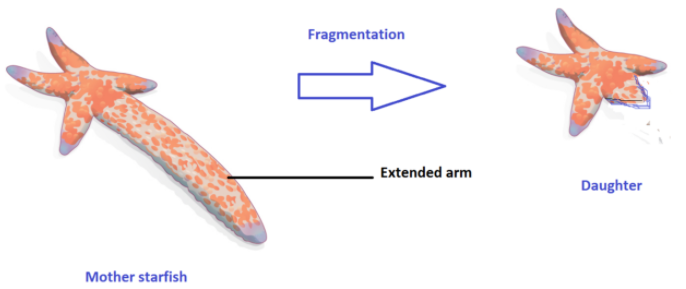
Describe the different method of asexual reproduction. Give Examples.
Answer
572.1k+ views
Hint: Asexual reproduction does not involve the fusion of gametes. The chromosome number remains unchanged. Also the off-springs are the exact copy of the parents.
Complete answer:
Asexual reproduction is the means of reproduction mainly in the single celled organisms like amoeba, bacteria and several fungi like yeast. It does not involve the fusion of gametes. The off-springs born are the exact copies of the parents. Asexual mode of reproduction can take place by several methods like
>Budding- Certain cells like yeast multiply by budding. It results in the mother cell and a daughter cell. The daughter cell formed is generally smaller than the mother cell. Certain multicellular organisms like hydra reproduce by bud formation. The bud grows in the mother and when matured eventually breaks from the parent organism.
>Fragmentation- It is a type of asexual reproduction where a new organism grows from a fragment of the parent. The fragment grows and matures into a new organism. This type of reproduction is seen in many annelids, starfish.

Binary fission- Prokaryotes reproduce through binary fission. In this type of reproduction, parent divide in two identical daughters. Example -amoeba.
Additional Information: Other modes of asexual reproduction are spore formation, vegetative propagation as seen in many plants like potato.
Note: Asexual reproduction is mostly seen in lower unicellular animals. Several plants and animals also reproduce asexually. The off-springs produced are exact copies of the parent. The number of chromosomes also remains unchanged.
Complete answer:
Asexual reproduction is the means of reproduction mainly in the single celled organisms like amoeba, bacteria and several fungi like yeast. It does not involve the fusion of gametes. The off-springs born are the exact copies of the parents. Asexual mode of reproduction can take place by several methods like
>Budding- Certain cells like yeast multiply by budding. It results in the mother cell and a daughter cell. The daughter cell formed is generally smaller than the mother cell. Certain multicellular organisms like hydra reproduce by bud formation. The bud grows in the mother and when matured eventually breaks from the parent organism.
>Fragmentation- It is a type of asexual reproduction where a new organism grows from a fragment of the parent. The fragment grows and matures into a new organism. This type of reproduction is seen in many annelids, starfish.

Binary fission- Prokaryotes reproduce through binary fission. In this type of reproduction, parent divide in two identical daughters. Example -amoeba.
Additional Information: Other modes of asexual reproduction are spore formation, vegetative propagation as seen in many plants like potato.
Note: Asexual reproduction is mostly seen in lower unicellular animals. Several plants and animals also reproduce asexually. The off-springs produced are exact copies of the parent. The number of chromosomes also remains unchanged.
Recently Updated Pages
Master Class 12 Business Studies: Engaging Questions & Answers for Success

Master Class 12 Economics: Engaging Questions & Answers for Success

Master Class 12 English: Engaging Questions & Answers for Success

Master Class 12 Maths: Engaging Questions & Answers for Success

Master Class 12 Social Science: Engaging Questions & Answers for Success

Master Class 12 Chemistry: Engaging Questions & Answers for Success

Trending doubts
Who was the first woman to receive Bharat Ratna?

Write a letter to the principal requesting him to grant class 10 english CBSE

Why is there a time difference of about 5 hours between class 10 social science CBSE

What is the median of the first 10 natural numbers class 10 maths CBSE

The Equation xxx + 2 is Satisfied when x is Equal to Class 10 Maths

Discuss the main reasons for poverty in India




